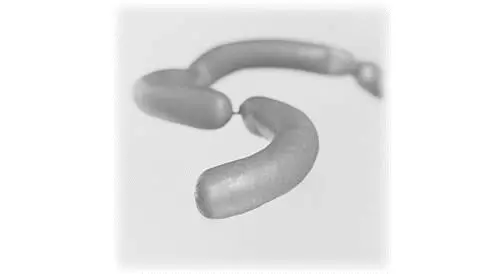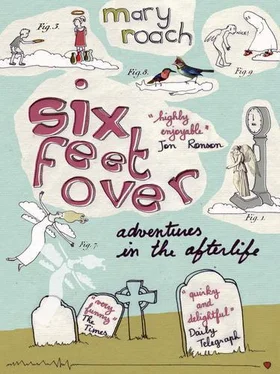Nahum’s idea is also a tough sell among nonacademics. Because, as he puts it, “People either think they already know the answer and don’t want any external validation, or they think it’s impossible to know the answer. They don’t have enough of a background to understand that they can know.”
And then there are budget constraints. Nahum estimates he’d need at least $100,000 in funding. “People have said to me, ‘We’re going to take this up the ladder, see what we can do.’ But it’s not a mainstream, high-priority enough idea that anyone says, ‘Here, let’s commit the money.’”
What about the physics department here at Duke? “I get blank stares.”
I begin to feel sad for this misunderstood man with his grand and misunderstood—or just not understood—vision.
“Does your wife understand your project?”
“Ex-wife. Not even a little.”
Nahum takes a phone call from a business partner named Al. “You’re wrong, Al!” he is yelling good-naturedly into the phone. “Al… AL! You’re all wet, Al!”
I put away my gauzy pastoral of the lonely philosopher. Gerry Nahum is a tall, charming, pedigreed gynecologist with healthy self-esteem. One day he’ll get the support he needs to carry out his plan, and possibly the respect of the Duke physicists, and maybe even a wife who knows quantum theory. I The giddy, revolting heyday of ectoplasm hope so.
IT IS 2 P.M. before Nahum’s stomach makes itself heard over his brain and we break for lunch. With the equations put away and at least a few picograms of Nahum’s informational content devoted to his ravioli, I feel more comfortable asking the dimwit questions I’ve wanted to ask all morning.
What do you think it would feel like to be a free-floating soul, a fart of energy in some god-knows-where-or-what dimension? Nahum makes the analogy of the computer: Your basic core of consciousness, he imagines, would be like the operating system. On top of that you have various overlays: word processing and spreadsheet programs and such if you’re a computer; if you’re a human being, perception, language, reason, memory. When you die and the brain shuts down, the overlays fritz out. You’re left with the operating system: a sort of a primitive, free-floating awareness. Nahum imagines existence would be “like what it is for us now, minus all the superficial trappings.”
It’s that minus-all-the-trappings bit that gets me. If you can’t think in words or see or hear, what are you like? Coma victim? Lichen? Nahum shrugs. It’s just an analogy, just a guess. I posed this question to Lui later in the week. He was dubious about the possibility of the informational content of a person’s consciousness leaving the body in any sort of organized form. “Decay heat is not ordered information,” he said. Meaning, I think, that the blip of energy that was your personality may indeed continue to exist after you die, but not in the form of your personality. Not in the form of something you can be or use.
I later relayed to Nahum what Lui said and asked him to comment. “Remember,” I wrote, “in replying to me, pretend you are talking to a seventh-grader.” Nahum disagreed with Lui. His reply ran to a thousand words and would have been understandable to any seventh-grader familiar with Kant, Locke, negentropy as the measure of nonrandomness, and the Enigma encryption machine. Here is the part I understood: “This energy is freely malleable in terms of the physical form it might take… and it is not necessarily the case that any one of them would be ‘preferred.’”
Well, “preferred” in the sense that it would be more fun to be a spirit that can think thoughts and remember memories than to be, say, a black hole or a piece of static electricity. But I decided to leave it be.
Nahum orders bananas Napoleon for dessert, just one more way we’ll never understand each other. We’re back to talking about the box, the system. I realize I forgot to ask him what kind of organism he’s planning to put inside. The dessert arrives, a massive custard download held vertical by wafer shelving.
“So what goes in it?” I’d been assuming a lab mouse.
“Banana pudding, mostly.”
When I get back home and I look at Nahum’s twenty-five-page “Proposal for Testing the Energetics of Consciousness and Its Physical Foundation,” I will picture a plate of banana pudding in a box.
Theoretically, Nahum could sacrifice anything from a bacterium on up. He is leaning toward leeches. “I worked with leeches for a long time. They’re slimy and they latch on to you. They’re a very awful organism. I hated those things!” The couple at the table beside us turn to look at the man who hates leeches.
Last question: What does he think the result will be? Does free-floating consciousness energy exist? “My bias is that it does exist,” says Nahum. “But I would never say that I know that.” He puts down his spoon. “Until I prove it.”
4. THE VIENNA SAUSAGE AFFAIR
And Other Dubious Highlights of the Ongoing Effort to See the Soul

THE YEAR WAS 1911. Duncan Macdougall, feeling fairly certain he had proved the existence of the soul (by weighing it), now was determined to see it. He wanted, he said in a newspaper article from that year, to know what color [16] Anecdotal data on this matter comes from a former nurses’ aide named Juli Pankow, who e-mailed me regarding her observation of what she took to be the soul of a dying nursing home patient. The room was dark. She had just heard the woman’s death rattle. “There was a greenish-purple very very faint cloud or haze right above the chest.” From a Google search, I learned that exploded barium can appear as a greenish-purple cloud, though the cloud in question was linked to a NASA project, not post-barium-enema gas, so who knows.
the soul was and how large it was in relation to the body. He wanted to know what route it took on the way out. Did it emanate from the heart or the top of the head, or did it perhaps escape “from the lips,” like a yawn or a cartoon character’s speech? Ignoring the growing disapproval of hospital and asylum boards, Macdougall recruited yet another batch of fading consumptives.
This time around, the dying men lay on an ordinary bed, in a darkened room. At “the supreme moment,” as Macdougall put it, he aimed a strong beam of light along the length of the patient’s body. First he used a swath of white light, and then he experimented with the individual colors of the spectrum, using a long glass prism to separate the bands of light. He tried it with the spectrum horizontal and then with it vertical. He detected nothing.
Macdougall concluded that the soul’s index of refraction is zero, and since all substances except “the ether of space” give some refraction of light, the soul was therefore made of ether. A word about ether. In pre-Einstein days, ether was an accepted concept in physics. It was thought to be the necessary medium for the transmission of electromagnetic waves (light, sound, radio, et cetera). Ether was invisible and undetectable, and it permeated all forms of matter, from man to ottoman.
It was also assumed to be weightless, which threw a hitch into Macdougall’s soul-as-ether idea. Unwilling to abandon his theory, Macdougall went public in 1914 with an “astounding theory,” as one headline put it, about how both ether and souls in fact were subject to the laws of gravity. Because if they weren’t, he reasoned, it would follow that “ever since human beings began to die upon the earth, the complex pathway of the earth around the sun in space… [would be] littered with these… nongravitative spiritual principles.” In other words, if gravity didn’t hold dead souls here on earth, they’d drift away into space, relegated to an eternity among the derelict satellites and NASA detritus. “Can we construct a conception of an orderly future life out of such conditions?”
Читать дальше












